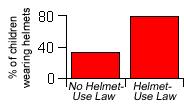|
December 19, 2001; Updated April 24, 2020
 Let's look at the
facts:
Let's look at the
facts:
- Approximately 28 million children in the US ride bicycles.
- In 1998, 194 children (ages 5-14 years) in the US were killed while
riding bikes.
- Of the 194 children killed, 125 died of traumatic brain injuries.
- Each year, an estimated 20,000 children suffer a non-fatal brain
injury while riding a bike.
- Bicycle helmets prevent up to 85% of head injuries and 88% of serious
brain injuries.
- An estimated $395 is saved in medical and other costs for every
bicycle helmet sold.
 You would think that these statistics alone
would persuade people to wear a helmet while riding a bike. However, you
would be wrong. A 1994 survey reported that only about 50% of US children
owned a bike helmet and only 25% of these kids wore a helmet every time or
nearly every time they rode a bike. These numbers are different than
those from an informal poll on the Neuroscience
for Kids Brain Fitness web site where 3003 of 4189 people (72%)
responded that they wore a helmet every time they rode a bike. Also, of
these 3148 people, 788 (19%) said they sometimes wore a helmet and 398
(9%) said they never wore a helmet. You would think that these statistics alone
would persuade people to wear a helmet while riding a bike. However, you
would be wrong. A 1994 survey reported that only about 50% of US children
owned a bike helmet and only 25% of these kids wore a helmet every time or
nearly every time they rode a bike. These numbers are different than
those from an informal poll on the Neuroscience
for Kids Brain Fitness web site where 3003 of 4189 people (72%)
responded that they wore a helmet every time they rode a bike. Also, of
these 3148 people, 788 (19%) said they sometimes wore a helmet and 398
(9%) said they never wore a helmet.
So, what does it take to get someone to put on a bike
helmet?
Apparently, education and encouragement are not enough for many children.
According to a new study published in the American Journal of
Epidemiology, a LAW requiring children to wear helmets while bike
riding is the best way.
 On January 1, 1997, Florida State passed a law
requiring all
children younger than 16 years to wear a helmet while bike riding. For
one year, the police issued verbal warnings and passed out bicycle safety
literature. On January 1, 1998, the police were authorized to issue a $15
ticket to children riding bikes without wearing a helmet. However, the
state law allowed a county to "opt out" of new helmet use requirement.
Three counties decided that they did not want the new helmet use law. On January 1, 1997, Florida State passed a law
requiring all
children younger than 16 years to wear a helmet while bike riding. For
one year, the police issued verbal warnings and passed out bicycle safety
literature. On January 1, 1998, the police were authorized to issue a $15
ticket to children riding bikes without wearing a helmet. However, the
state law allowed a county to "opt out" of new helmet use requirement.
Three counties decided that they did not want the new helmet use law.
 Researchers in Florida watched children
riding their bikes to and from public schools across the state. They
counted the number of children who were and who were not wearing helmets
as they parked their bikes in the school bike racks. In counties
with a state helmet-use law, 16,907 of 21,313 (79%)
children wore helmets while riding their bikes. In counties
without the state helmet-use law, only 148 of 450 (33%)
children wore helmets. Researchers in Florida watched children
riding their bikes to and from public schools across the state. They
counted the number of children who were and who were not wearing helmets
as they parked their bikes in the school bike racks. In counties
with a state helmet-use law, 16,907 of 21,313 (79%)
children wore helmets while riding their bikes. In counties
without the state helmet-use law, only 148 of 450 (33%)
children wore helmets.
These data suggest that a helmet use law DOES promote
the use of bike helmets by children. Perhaps such a law would encourage
EVERYONE to strap on a helmet. Does your state, county or city have a
bike law? If you don't know, find out at the Bicycle Helmet Safety
Institute and Bicycle
Helmet Laws in America by States 2020. For more information about
bicycle helmet safety, see the Harborview Injury Prevention and
Research Center. |


![[email]](./gif/menue.gif)


